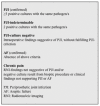The Role of Nuclear Medicine Imaging with 18F-FDG PET/CT, Combined 111In-WBC/99mTc-Nanocoll, and 99mTc-HDP SPECT/CT in the Evaluation of Patients with Chronic Problems after TKA or THA in a Prospective Study
- PMID: 35328234
- PMCID: PMC8947521
- DOI: 10.3390/diagnostics12030681
The Role of Nuclear Medicine Imaging with 18F-FDG PET/CT, Combined 111In-WBC/99mTc-Nanocoll, and 99mTc-HDP SPECT/CT in the Evaluation of Patients with Chronic Problems after TKA or THA in a Prospective Study
Abstract
Background: The aim of this prospective study was to assess the diagnostic value of nuclear imaging with 18F-FDG PET/CT (FDG PET/CT), combined 111In-WBC/99mTc-Nanocoll, and 99mTc-HDP SPECT/CT (dual-isotope WBC/bone marrow scan) for patients with chronic problems related to knee or hip prostheses (TKA or THA) scheduled by a structured multidisciplinary algorithm.
Materials and methods: Fifty-five patients underwent imaging with 99mTc-HDP SPECT/CT (bone scan), dual-isotope WBC/bone marrow scan, and FDG PET/CT. The final diagnosis of prosthetic joint infection (PJI) and/or loosening was based on the intraoperative findings and microbiological culture results and the clinical follow-up.
Results: The diagnostic performance of dual-isotope WBC/bone marrow SPECT/CT for PJI showed a sensitivity of 100% (CI 0.74-1.00), a specificity of 97% (CI 0.82-1.00), and an accuracy of 98% (CI 0.88-1.00); for PET/CT, the sensitivity, specificity, and accuracy were 100% (CI 0.74-1.00), 71% (CI 0.56-0.90), and 79% (CI 0.68-0.93), respectively.
Conclusions: In a standardized prospectively scheduled patient group, the results showed highly specific performance of combined dual-isotope WBC/bone marrow SPECT/CT in confirming chronic PJI. FDG PET/CT has an appropriate accuracy, but the utility of its use in the clinical diagnostic algorithm of suspected PJI needs further evidence.
Keywords: FDG PET/CT; bone scan; dual-isotope WBC/bone marrow scan; hybrid imaging; labeled leucocyte imaging; nuclear imaging; periprosthetic infection; prosthetic joint infection.
Conflict of interest statement
The authors declare no conflict of interest.
Figures









Similar articles
-
Role of Multimodal Imaging in Patients With Suspected Infections After the Bentall Procedure.Front Cardiovasc Med. 2021 Dec 1;8:745556. doi: 10.3389/fcvm.2021.745556. eCollection 2021. Front Cardiovasc Med. 2021. PMID: 34926606 Free PMC article.
-
FDG PET for diagnosing infection in hip and knee prostheses: prospective study in 221 prostheses and subgroup comparison with combined (111)In-labeled leukocyte/(99m)Tc-sulfur colloid bone marrow imaging in 88 prostheses.Clin Nucl Med. 2014 Jul;39(7):609-15. doi: 10.1097/RLU.0000000000000464. Clin Nucl Med. 2014. PMID: 24873788 Free PMC article.
-
99mTc-HMPAO-WBC SPECT/CT versus 18F-FDG-WBC PET/CT in chronic prosthetic joint infection: a pilot study.Nucl Med Commun. 2022 Feb 1;43(2):193-200. doi: 10.1097/MNM.0000000000001502. Nucl Med Commun. 2022. PMID: 34678830
-
Bone scan in painful knee arthroplasty: obsolete or actual examination?Acta Biomed. 2017 Jun 7;88(2S):68-77. doi: 10.23750/abm.v88i2-S.6516. Acta Biomed. 2017. PMID: 28657567 Free PMC article. Review.
-
Diagnostic Imaging in Vascular Graft Infection: A Systematic Review and Meta-Analysis.Eur J Vasc Endovasc Surg. 2018 Nov;56(5):719-729. doi: 10.1016/j.ejvs.2018.07.010. Epub 2018 Aug 16. Eur J Vasc Endovasc Surg. 2018. PMID: 30122333
Cited by
-
An artificial intelligence framework for the diagnosis of prosthetic joint infection based on 99mTc-MDP dynamic bone scintigraphy.Eur Radiol. 2023 Oct;33(10):6794-6803. doi: 10.1007/s00330-023-09687-w. Epub 2023 Apr 28. Eur Radiol. 2023. PMID: 37115217
-
Imaging in Periprosthetic Joint Infection Diagnosis: A Comprehensive Review.Microorganisms. 2024 Dec 24;13(1):10. doi: 10.3390/microorganisms13010010. Microorganisms. 2024. PMID: 39858778 Free PMC article. Review.
-
Simultaneous 18F-FDG-PET/MRI for the detection of periprosthetic joint infections after knee or hip arthroplasty: a prospective feasibility study.Int Orthop. 2022 Sep;46(9):1921-1928. doi: 10.1007/s00264-022-05445-7. Epub 2022 May 30. Int Orthop. 2022. PMID: 35635553 Free PMC article.
-
Diagnostic accuracy of positron emission tomography/computerized tomography for periprosthetic joint infection of hip: systematic review and meta-analysis.J Orthop Surg Res. 2023 Aug 30;18(1):640. doi: 10.1186/s13018-023-04061-4. J Orthop Surg Res. 2023. PMID: 37644493 Free PMC article.
-
Periprosthetic hip infection: Current concepts and the Wrightington experience.J Clin Orthop Trauma. 2024 Jul 28;55:102509. doi: 10.1016/j.jcot.2024.102509. eCollection 2024 Aug. J Clin Orthop Trauma. 2024. PMID: 39184529 Free PMC article.
References
-
- Khalid V., Schønheyder H.C., Larsen L.H., Nielsen P.T., Kappel A., Thomsen T.R., Aleksyniene R., Lorenzen J., Ørsted I., Simonsen O., et al. Multidisciplinary Diagnostic Algorithm for Evaluation of Patients Presenting with a Prosthetic Problem in the Hip or Knee: A Prospective Study. Diagnostics. 2020;10:98. doi: 10.3390/diagnostics10020098. - DOI - PMC - PubMed
LinkOut - more resources
Full Text Sources

